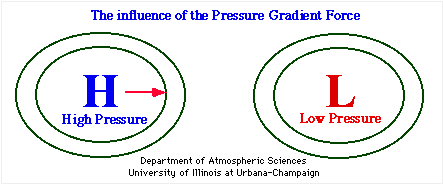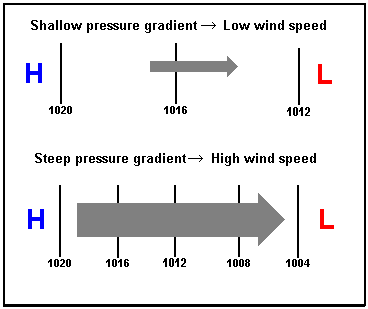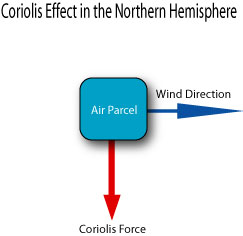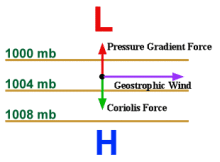|
Pressure Gradient Force
>> Moves air from higher to lower
pressure
 |
|
Figure 1:
This figure outlines the basic premise of the pressure gradient force.
This atmospheric force acts to move air from high pressure toward low
pressure. |
The pressure gradient force works to
move blobs of air from higher pressure toward lower pressure. Figure 1,
shown to the right, illustrates how the pressure gradient force works.
>> Wind speed generally increases as pressure gradient increases
|
 |
|
Figure 2:
This image shows the relationship between the strength of the pressure
gradient and the resulting wind speed. |
The change in pressure over a given distance is defined as a pressure gradient.
The strength of this pressure gradient determines how fast the wind
moves from higher pressure toward lower pressure. A stronger pressure gradient
will cause stronger winds, as shown in Figure 2.
>> Balanced in the vertical by the force of gravity
In the vertical, the upward pressure gradient force is
balanced by the downward force of gravity. This is known to meteorologists as
hydrostatic balance. Hydrostatic balance implies that motions of air in the vertical direction are highly
limited.
Coriolis Effect
>> A result of a rotating, spherical
earth
>> Apparent deflection to the right in the Northern Hemisphere
The Coriolis Effect is a direct result
of the fact that the earth is constantly rotating on its axis. This effect
causes an object in motion to appear as if it is being deflected to the right
(in the northern hemisphere). An object in motion appears to be
deflected to the left in the southern hemisphere. The Coriolis Effect is
not present directly at the equator.
>> Always acts 90 degrees to the right of the direction of the wind in the northern hemisphere
|

|
|
Figure 3:
The image above shows how the Coriolis force acts 90 degrees and to the
right of the wind direction. |
The Coriolis Effect has a profound impact on the direction of any moving object,
including the movement of air in the atmosphere. The force that is a
result of the Coriolis Effect always acts at 90 degrees to the right of
the direction of the wind. The Coriolis force can be seen in Figure 3.
>> Increases with increasing latitude
The impact of the Coriolis force
increases as the latitude increases. This apparent force varies from zero
directly over the Equator to its maximum value at the poles.
Friction
>> Acts to decrease the wind speed
>> Depends on the roughness of the surface below (increasing roughness = increasing
friction)
>> Always acts at 180 degrees to (opposite) the direction of the wind
The force of friction is a drag force.
This force always acts to oppose the motion of an object, whether that object be
a car or the wind. The frictional force is most prevalent at the surface
and decreases as altitude increases.
>> Ultimately reduces deflection due to Coriolis Force
The force due to friction not only
works to oppose the motion of any moving object, but it also has an impact on
the amount an object is deflected by the Coriolis force. This is because
the Coriolis force not only depends on latitude, but also
the speed of the object. When the frictional force reduces the speed of
the moving object, it also decreases the impact of the Coriolis force. The
ultimate impact of all three forces mentioned above can be seen in the
demonstration at the bottom of this page.
>> Winds cross isobars at approximately 30 degrees
|
 |
|
Figure 4:
This figure shows the balance of the pressure gradient force and the
Coriolis force. This balance is known as the geostrophic balance. |
In a world without friction, the pressure gradient and Coriolis forces
would exactly balance one another. This type of balance, called
geostrophic balance by meteorologists, causes wind to move parallel to isobars.
This case can be seen in Figure 4.
|
|
|
Figure 5:
This movie illustrates how friction impacts airflow around high and low
pressure systems. |
Friction cannot be ignored when considering atmospheric
motions, especially those near the ground. The addition of friction ultimately causes the wind to move
approximately at a 30 degree angle to the isobars from higher toward lower pressure.
This, in turn, causes low pressure systems to be associated with counterclockwise rotation,
covergence and rising air, while high pressure systems rotate in a clockwise fashion and are
associated with divergence and sinking air. This concept is
further explained by the movie found in Figure 5.
Finally, all of these concepts can be
combined to give a more realistic view of how the wind moves in the atmosphere.
The application found below outlines all of the three forces mentioned above and
their impacts on the motion of the wind.
|
|
|
Figure 6:
The application above outlines the various forces that have an impact on the
motion of the wind. In order to view the impact of each combination of
forces, please click on the radio buttons next to each choice and then push
play. |
|